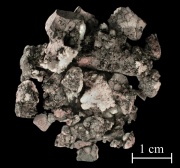Difference between revisions of "Archil"
| Line 2: | Line 2: | ||
== Description == | == Description == | ||
| − | A bright red to rich purple color natural dye that was obtained from any of several lichens of the genera ''Evernia, Roccella, Ramalina'' and ''Lecanoria'', such as ''Evernia prunastri'', ''Roccella phycopsis'' and ''Ramalina scopulorum''. Lichens were used by the Egyptians for dyes. In the Middle Ages, the preparation of archil was rediscovered by Federigo, an Italian, who developed a monopoly on the red colorant; it was used to make the brilliant reds and purples in Florentine cloth. It was not until the 18th century that a Scottish chemist, C. Gordon, also discovered, then patented, the process for making archil which he called [[cudbear|cudbear]]. The dark red color in archil is formed when lecanoric acid is converted to orcein by fermentation then oxidation. Archil is an indicator dye which turns blue in alkaline solutions. It has moderate lightfastness. French purple is the name for a lake pigment made from archil (Mayer 1969). Archil was primarily used for textile dyeing; it also found uses as a wood stain and food colorant. | + | A bright red to rich purple color natural dye that was obtained from any of several lichens of the genera ''Evernia, Roccella, Ramalina'' and ''Lecanoria'', such as ''Evernia prunastri'', ''Roccella phycopsis'' and ''Ramalina scopulorum''. Lichens were used by the Egyptians for dyes. In the Middle Ages, the preparation of archil was rediscovered by Federigo, an Italian, who developed a monopoly on the red colorant; it was used to make the brilliant reds and purples in Florentine cloth. It was not until the 18th century that a Scottish chemist, C. Gordon, also discovered, then patented, the process for making archil which he called [[cudbear|cudbear]]. The dark red color in archil is formed when lecanoric acid is converted to [[orcein]] by fermentation then oxidation. Archil is an indicator dye which turns blue in alkaline solutions. It has moderate lightfastness. French purple is the name for a lake pigment made from archil (Mayer 1969). Archil was primarily used for textile dyeing; it also found uses as a wood stain and food colorant. |
== Synonyms and Related Terms == | == Synonyms and Related Terms == | ||
Revision as of 09:32, 26 June 2020
Description
A bright red to rich purple color natural dye that was obtained from any of several lichens of the genera Evernia, Roccella, Ramalina and Lecanoria, such as Evernia prunastri, Roccella phycopsis and Ramalina scopulorum. Lichens were used by the Egyptians for dyes. In the Middle Ages, the preparation of archil was rediscovered by Federigo, an Italian, who developed a monopoly on the red colorant; it was used to make the brilliant reds and purples in Florentine cloth. It was not until the 18th century that a Scottish chemist, C. Gordon, also discovered, then patented, the process for making archil which he called Cudbear. The dark red color in archil is formed when lecanoric acid is converted to Orcein by fermentation then oxidation. Archil is an indicator dye which turns blue in alkaline solutions. It has moderate lightfastness. French purple is the name for a lake pigment made from archil (Mayer 1969). Archil was primarily used for textile dyeing; it also found uses as a wood stain and food colorant.
Synonyms and Related Terms
Evernia prunastri; Roccella phycopsis; Ramalina scopulorum; Natural Red 28; CI 758600; cudbear (Scot.); Archil (Deut.); Französischer Purpur (Deut.); orseille (Fr.); Kraut orseille (Deut.); rocella (It.); raspa (It.); oricello (It.); orchillo (Esp.); liquen orceilla (Esp.); orseiini (Fin.); orchil (Ned.); líquene (Port.); archal; orcein; orchil; orcin; orchilla; archella weeds; red indigo; vercella; kenkerig; cork blue; arcel; French purple; French purpure; pourpre francais; French sand; orchella; persis; couc; lakmoes; litmus; lecanoic acid
Other Properties
Orcein is soluble in ethanol. It is an indicator dye that turns blue in alkaline solutions.
| CAS | 1400-62-3 |
|---|
Resources and Citations
- J.Hofenk-de Graaf, Natural Dyestuffs: Origin, Chemical Constitution, Identification, Central Research Laboratory for Objects of Art and Science, Amsterdam, September 1969.
- Helmut Schweppe, Schweppe color collection index and information book
- Ralph Mayer, A Dictionary of Art Terms and Techniques, Harper and Row Publishers, New York, 1969 (also 1945 printing)
- Palmy Weigle, Ancient Dyes for Modern Weavers, Watson-Guptill Publications, New York, 1974
- Colour Index International online at www.colour-index.org
- J. Thornton, 'The Use of Dyes and Colored Varnishes in Wood Polychromy', Painted Wood: History and Conservation, The Getty Conservation Insitute, Los Angeles, 1998
- G.S.Brady, Materials Handbook, McGraw-Hill Book Co., New York, 1971 Comment: p. 183
- Matt Roberts, Don Etherington, Bookbinding and the Conservation of Books: a Dictionary of Descriptive Terminology, U.S. Government Printing Office, Washington DC, 1982
- Wikipedia: http://en.wikipedia.org/wiki/Archil (Accessed Jan. 15, 2006)
- The Merck Index, Martha Windholz (ed.), Merck Research Labs, Rahway NJ, 10th edition, 1983 Comment: entry 6994
- Website: http://www.coloria.net/varita.htm - Finnish name
- The American Heritage Dictionary or Encarta, via Microsoft Bookshelf 98, Microsoft Corp., 1998
- Art and Architecture Thesaurus Online, http://www.getty.edu/research/tools/vocabulary/aat/, J. Paul Getty Trust, Los Angeles, 2000
